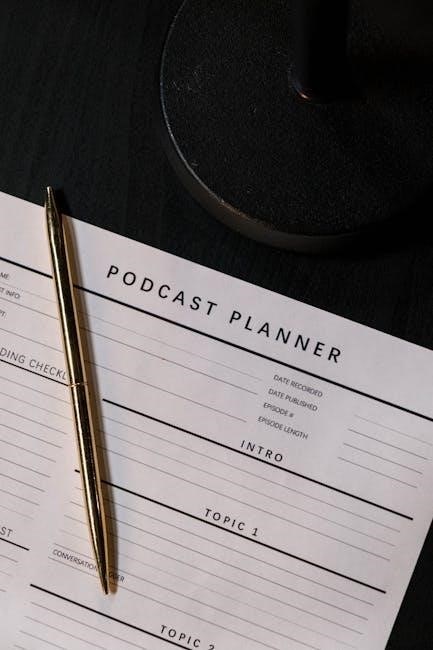cbt for psychosis worksheets pdf

CBT worksheets offer a structured approach to managing psychosis, helping individuals identify triggers, develop coping skills, and track progress. These evidence-based tools are designed for clinicians to support effective therapy sessions.
1.1 Overview of CBT in Managing Psychosis
Cognitive Behavioral Therapy (CBT) is a valuable approach for managing psychosis, focusing on identifying and challenging unhelpful thoughts and beliefs. It helps individuals understand how their thoughts, feelings, and behaviors are interconnected, enabling them to develop more adaptive coping strategies. CBT for psychosis (CBTp) emphasizes the importance of collaboration between the therapist and client, fostering a supportive environment for exploration and change. Worksheets play a crucial role in this process, providing structured exercises to track symptoms, identify triggers, and practice cognitive restructuring. By addressing delusions, hallucinations, and other psychotic symptoms, CBTp aims to improve daily functioning and quality of life. The therapy is evidence-based, with studies showing its effectiveness in reducing symptom severity and enhancing recovery outcomes. Worksheets also serve as practical tools for clinicians to guide sessions and monitor progress, making CBTp a comprehensive and accessible intervention for individuals experiencing psychosis.
1.2 Importance of Worksheets in CBT
CBT worksheets are essential tools in managing psychosis, offering a structured and organized approach to therapy. They provide individuals with a clear framework to identify triggers, monitor symptoms, and develop coping strategies. Worksheets enable clients to engage actively in their treatment, fostering a sense of control and empowerment. For clinicians, these resources serve as practical guides for case formulation and intervention planning. They often include exercises for cognitive restructuring, helping individuals challenge and reframe distorted thoughts. Worksheets also facilitate progress tracking, allowing both clients and therapists to assess improvements over time. Many worksheets are available as downloadable PDFs, making them easily accessible and convenient for use in sessions or as homework assignments. Overall, worksheets enhance the effectiveness of CBT for psychosis by providing a tangible and evidence-based foundation for therapy.

What is CBT for Psychosis?
CBT for psychosis (CBTp) is a therapeutic approach focusing on changing negative thought patterns and behaviors; It helps individuals manage symptoms like delusions and hallucinations, improving their quality of life through structured techniques and evidence-based worksheets.
2.1 Definition and Scope
Cognitive Behavioral Therapy for psychosis (CBTp) is a specialized form of CBT tailored to address psychotic symptoms such as delusions, hallucinations, and disorganized thinking. It focuses on helping individuals understand how their thoughts, feelings, and behaviors are interconnected. The scope of CBTp extends beyond symptom management, aiming to improve quality of life, social functioning, and emotional well-being. Worksheets play a central role in this process, providing structured exercises to identify and challenge unhelpful thought patterns, track symptoms, and develop coping strategies. These tools are evidence-based, derived from established CBT models, and are designed to be user-friendly for both clinicians and patients. By addressing the unique challenges of psychosis, CBTp offers a practical and empowering approach to recovery, emphasizing collaboration between the therapist and client.
2.2 Key Principles of CBTp
Cognitive Behavioral Therapy for psychosis (CBTp) is rooted in the belief that psychotic symptoms are influenced by cognitive processes. A central principle is collaboration between the therapist and client, fostering a non-judgmental and empathetic relationship. Another key principle is the normalization of symptoms, helping individuals understand that psychotic experiences can be part of the human continuum. CBTp emphasizes the identification of unhelpful thought patterns and behaviors, such as jumping to conclusions or avoidance, and works to reframe these through evidence-based techniques. Worksheets are integral to this process, providing structured exercises to explore and challenge delusional beliefs or hallucinations. The therapy also focuses on enhancing coping strategies and improving daily functioning. By addressing both cognitive distortions and behavioral responses, CBTp aims to reduce symptom distress and improve quality of life, offering a practical and empowering approach to managing psychosis.

Benefits of Using CBT Worksheets

CBT worksheets provide a structured and supportive way to manage psychosis, helping users identify triggers, develop coping skills, and track their progress effectively.

3.1 Structured Approach to Therapy
CBT worksheets provide a clear and organized framework for managing psychosis, ensuring consistent progress in therapy. These tools guide users through structured exercises to identify triggers, challenge distorted cognitions, and develop adaptive coping strategies. By offering a step-by-step approach, worksheets help individuals systematically address symptoms like delusions and hallucinations. They also facilitate the tracking of progress, enabling both patients and clinicians to monitor improvements over time. The structured nature of these worksheets ensures that therapy sessions remain focused and goal-oriented, making the therapeutic process more effective. Additionally, they are based on evidence-based models, ensuring reliability and professionalism in clinical settings. This structured approach not only enhances the clarity of therapy but also empowers individuals to take an active role in their recovery journey.
3.2 Enhanced Coping Skills Development
CBT worksheets play a crucial role in enhancing coping skills for individuals managing psychosis. These tools provide practical exercises to help users identify and challenge distorted cognitions, reframe unhelpful thoughts, and develop adaptive behaviors. By focusing on specific techniques like cognitive restructuring and behavioral activation, worksheets empower patients to manage symptoms such as delusions and hallucinations more effectively. They also encourage the development of problem-solving skills, enabling individuals to navigate daily challenges with greater confidence. Clinicians can use these worksheets to guide patients in practicing mindfulness and emotional regulation, further strengthening their ability to cope with distressing situations. Over time, these skills contribute to improved mental health outcomes, enhancing overall well-being and quality of life. The structured nature of worksheets ensures that coping strategies are learned and applied consistently, fostering long-term resilience and recovery.

Key Components of CBT Worksheets
CBT worksheets for psychosis include case conceptualization, cognitive restructuring, and behavioral activation. These components help identify triggers, reframe thoughts, and develop adaptive behaviors to manage symptoms effectively.
4.1 Case Conceptualization
Case conceptualization is a cornerstone of CBT for psychosis, providing a framework to understand an individual’s unique experience of symptoms, triggers, and underlying beliefs. Worksheets guide clinicians in mapping personal history, symptom patterns, and cognitive distortions. This process helps identify how thoughts, feelings, and behaviors interconnect, forming a clear treatment roadmap. By structuring this analysis, worksheets ensure a personalized approach, making therapy more effective. They also aid in monitoring progress and adjusting interventions as needed. This collaborative tool fosters insight and empowers individuals to manage their psychosis proactively, aligning with evidence-based practices highlighted in CBTp manuals and research.
4.2 Cognitive Restructuring Techniques
Cognitive restructuring is a core technique in CBT for psychosis, focusing on identifying and challenging distorted or unhelpful thoughts. Worksheets guide individuals in recognizing patterns of negative thinking and exploring alternative, more balanced perspectives. This process helps reduce distress associated with delusions or hallucinations. Techniques include questioning evidence for and against beliefs, examining the impact of thoughts on emotions, and practicing reality-testing exercises. Behavioral experiments are also incorporated to test the validity of beliefs in real-life situations. These structured activities empower individuals to manage symptoms more effectively and develop a more adaptive way of thinking. By addressing cognitive distortions, worksheets facilitate lasting changes in perception and behavior, enhancing overall mental health outcomes.
4.3 Behavioral Activation Strategies
Behavioral activation strategies in CBT for psychosis focus on helping individuals engage in meaningful activities despite psychotic symptoms. Worksheets guide users in identifying and scheduling activities that align with their goals and values. This approach aims to reduce avoidance behaviors and improve daily functioning. By breaking tasks into smaller, manageable steps, individuals can gradually rebuild confidence and reduce the impact of symptoms on their lives. These strategies also emphasize the importance of self-monitoring and reflection, allowing individuals to track their progress and identify patterns of behavior. Behavioral activation is particularly effective in addressing negative symptoms, such as apathy and social withdrawal, by fostering a sense of purpose and routine. Through structured exercises, individuals learn to reconnect with activities they enjoy, enhancing their overall quality of life and mental well-being.

How to Use CBT Worksheets Effectively
CBT worksheets for psychosis help identify triggers, track progress, and develop coping strategies. Regular use with a therapist enhances self-awareness and symptom management, promoting long-term recovery and well-being.
5.1 Identifying Triggers and Symptoms
CBT worksheets for psychosis are designed to help individuals systematically identify triggers and symptoms. These tools guide users to document specific situations, emotions, and thoughts associated with psychotic episodes. By tracking patterns, individuals can gain insight into what precipitates their symptoms, such as stress, certain environments, or substance use. Worksheets often include sections for rating symptom severity and exploring underlying beliefs. This process, supported by evidence-based models, enables individuals to recognize early warning signs and develop strategies to manage them. The structured format of these worksheets ensures clarity and consistency, making it easier for both patients and clinicians to monitor progress over time. Regular use of these tools fosters a collaborative approach to therapy, empowering individuals to take an active role in their recovery.
5.2 Tracking Progress and Reflection
CBT worksheets for psychosis include sections for tracking progress and reflection, enabling individuals to monitor changes in symptoms and coping strategies over time. These tools allow users to document improvements, setbacks, and insights, fostering a deeper understanding of their experiences. Reflection is a key component, as it helps individuals identify patterns and evaluate the effectiveness of their strategies. Worksheets often prompt users to consider what worked well and what could be improved, encouraging a proactive approach to managing psychosis. Regular reflection also enhances self-awareness and motivation, empowering individuals to take control of their recovery. Clinicians can review these reflections to refine treatment plans, ensuring a collaborative and adaptive therapeutic process. By maintaining a record of progress, individuals can celebrate successes and address challenges, reinforcing their commitment to long-term well-being.
5.3 Homework Assignments and Activities
CBT worksheets for psychosis often include homework assignments and activities designed to reinforce skills learned during therapy sessions. These tasks encourage individuals to apply cognitive restructuring, behavioral activation, and coping strategies in real-life situations. Activities may involve practicing thought challenging, recording daily achievements, or engaging in activities that promote emotional regulation. Homework assignments help bridge the gap between therapy sessions, ensuring continuous progress and reinforcing new behaviors. Worksheets may also include space for reflecting on completed activities, allowing individuals to identify what worked well and what could be improved. By completing these assignments, individuals develop greater self-awareness and independence in managing their symptoms. Clinicians can review these activities during sessions to provide feedback and adjust treatment plans accordingly, ensuring a personalized and effective approach to therapy. Regular homework completion is a key factor in achieving long-term recovery and improved quality of life.

Evidence Supporting CBT Worksheets
CBT worksheets are supported by clinical studies and meta-analyses, demonstrating their effectiveness in reducing psychotic symptoms and improving quality of life. Research highlights their role in structured, evidence-based interventions.
6.1 Clinical Studies and Meta-Analyses
Clinical studies and meta-analyses consistently demonstrate the effectiveness of CBT worksheets in managing psychosis. Research by Mehl et al. (2015) highlights CBT’s role in reducing delusions, with significant effect sizes observed. A randomized controlled trial found that while CBT did not outperform clinical management for individuals at high risk of psychosis, it remains a valuable adjunct to antipsychotic medication. Another study emphasized the benefits of combining CBT with family intervention, showing improved outcomes for early psychosis. These findings underscore the structured, evidence-based nature of CBT worksheets, which are widely recommended by organizations like NICE for individuals with psychosis. The empirical support for these tools reinforces their utility in clinical practice, offering a practical and effective approach to symptom management and recovery.
6.2 Comparison with Other Therapies
CBT worksheets for psychosis are often compared to other therapies, such as family intervention and medication. Studies suggest that while CBT may not always outperform these treatments, it offers unique benefits, particularly in reducing delusions and hallucinations. Unlike medication, CBT focuses on empowering individuals to manage symptoms through cognitive restructuring and behavioral strategies. Family intervention, on the other hand, emphasizes relational dynamics, whereas CBT worksheets provide a structured, individualized approach. Research indicates that combining CBT with other therapies, such as antipsychotic medication, can enhance outcomes for early psychosis. NICE guidelines recommend CBT as a first-line treatment for psychosis, highlighting its effectiveness compared to other interventions. Overall, CBT worksheets offer a practical, evidence-based tool that complements broader treatment plans, making them a valuable option for clinicians and patients alike.
6.3 Real-World Applications and Success Stories
CBT worksheets for psychosis have shown significant real-world success in helping individuals manage symptoms. For instance, studies highlight that CBT interventions can reduce paranoia and hallucinations, improving overall well-being. A randomized controlled trial demonstrated that CBT, combined with medication, improved outcomes for early psychosis. Additionally, the Think CBT Workbook, a widely used resource, provides practical tools for clinicians and patients, offering structured exercises to address delusions and distressing beliefs. Many patients report improved coping skills and reduced symptom severity after using these worksheets. Clinicians also appreciate the downloadable PDF formats, which make implementation easier. Success stories often emphasize how CBT worksheets empower individuals to take an active role in their recovery, fostering independence and resilience. These tools are particularly valued for their accessibility and effectiveness in diverse clinical settings.

Resources for Clinicians and Patients
CBT worksheets for psychosis are available as downloadable PDFs, offering structured tools for clinicians and patients. Recommended workbooks and manuals provide evidence-based strategies for managing symptoms effectively.
7.1 Recommended Workbooks and Manuals
Several workbooks and manuals are highly recommended for clinicians and patients engaging in CBT for psychosis. The Think CBT Workbook is a popular resource, offering structured exercises and worksheets to help individuals manage psychotic symptoms. It is available as a downloadable PDF, allowing users to print and complete exercises manually. Additionally, manuals by experts like McGlashan provide comprehensive guides for therapists, including formulation and intervention strategies. These resources emphasize evidence-based approaches, focusing on case conceptualization and cognitive restructuring. They are designed to support both clinicians in their practice and patients in their journey toward recovery. By leveraging these tools, individuals can better understand their condition, identify triggers, and develop coping strategies. These workbooks and manuals are invaluable for effective CBTp implementation, ensuring a structured and supportive therapeutic process.
7.2 Downloadable PDF Worksheets
Downloadable PDF worksheets are essential tools for CBTp, offering a practical and accessible way to support therapy sessions. These worksheets are often fillable, allowing users to complete them digitally or print them for manual use. Many resources, such as the Think CBT Workbook, provide static PDF versions that can be easily accessed and used by both clinicians and patients. These worksheets are designed to guide individuals through CBT techniques, helping them identify and challenge distorted cognitions, track symptoms, and develop coping strategies. They often include exercises for case conceptualization, cognitive restructuring, and behavioral activation. Downloadable PDFs are particularly useful for homework assignments, enabling consistent practice outside of therapy sessions. Resources like those from Doenges et al. and other CBTp manuals offer comprehensive, professionally formatted tools that align with evidence-based practices; These worksheets are invaluable for structuring therapy and promoting progress in managing psychotic symptoms.
7.3 Online Platforms for CBT Materials
Online platforms provide convenient access to CBT materials, including worksheets and manuals, for both clinicians and patients. Websites like the American Psychiatric Association and other CBT-focused resources offer downloadable PDFs, such as the Think CBT Workbook, which includes static PDF versions of worksheets. These materials are designed to support therapy sessions and homework assignments, allowing individuals to practice techniques outside of clinical settings. Many platforms also offer fillable PDFs, enabling users to complete exercises digitally. Resources such as those from Doenges et al. and other CBTp manuals are widely available online, providing structured tools for case conceptualization, cognitive restructuring, and behavioral activation. These platforms are invaluable for clinicians seeking professionally formatted materials and for patients looking to access evidence-based resources. Online accessibility ensures that CBT worksheets are readily available to support effective therapy and symptom management.

Future Directions in CBT for Psychosis
Advancements in worksheet design and integration with digital therapies are expected to enhance accessibility and effectiveness. Expanding training and resources will further support clinicians and patients in managing psychosis.
8.1 Advancements in Worksheet Design
Advancements in worksheet design for CBT for psychosis are focused on creating more interactive and personalized tools. Digital enhancements, such as fillable PDFs and multimedia integration, improve accessibility and engagement. Worksheets now incorporate tailored exercises based on individual needs, allowing for more precise interventions. The development of adaptive worksheets that adjust to patient progress ensures a dynamic therapy experience. Additionally, advancements in design prioritize clarity and user-friendliness, making worksheets more effective for both clinicians and patients. These innovations aim to enhance the therapeutic process, fostering better engagement and outcomes in managing psychosis.
8.2 Integration with Digital Therapies
The integration of CBT worksheets with digital therapies has revolutionized psychosis treatment. Online platforms now offer interactive CBT tools, enabling patients to access worksheets remotely. Digital therapies, such as web-based CBT interventions, have shown promise in reducing symptoms like insomnia and paranoia. These platforms often include fillable PDFs, progress tracking, and personalized feedback, enhancing engagement. Digital integration also allows for real-time data collection, aiding clinicians in tailoring interventions. Studies suggest that combining digital therapies with traditional CBT worksheets improves accessibility and consistency. This approach is particularly beneficial for individuals with limited access to in-person therapy. As technology advances, the fusion of digital tools with CBT worksheets promises to enhance treatment outcomes for psychosis, making care more accessible and effective.
8.3 Expanding Accessibility and Training
Expanding accessibility and training is crucial for maximizing the benefits of CBT worksheets for psychosis. Clinicians and patients can now access downloadable PDFs and online platforms offering CBT materials, ensuring wider reach. Training programs for clinicians emphasize the effective use of worksheets, enhancing therapy outcomes; The development of standardized training protocols and certification courses is ongoing, aiming to equip mental health professionals with the skills needed to implement CBTp effectively; Additionally, public awareness campaigns and educational resources are being promoted to reduce stigma and encourage early intervention. By improving accessibility and training, the goal is to ensure that evidence-based CBT tools reach those in need, fostering better mental health care globally.